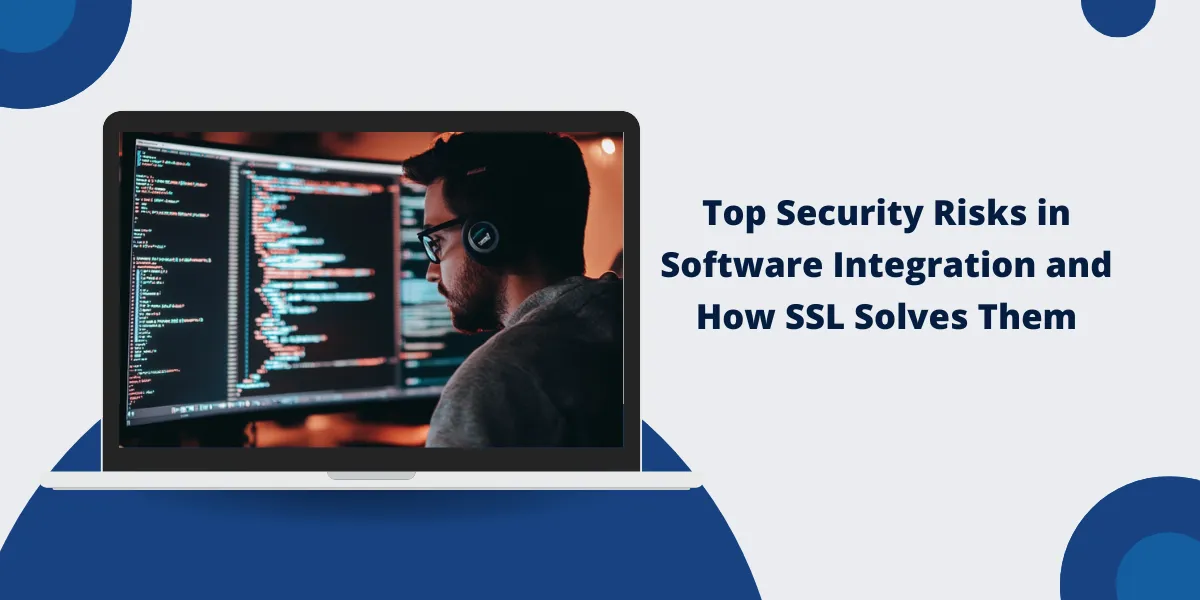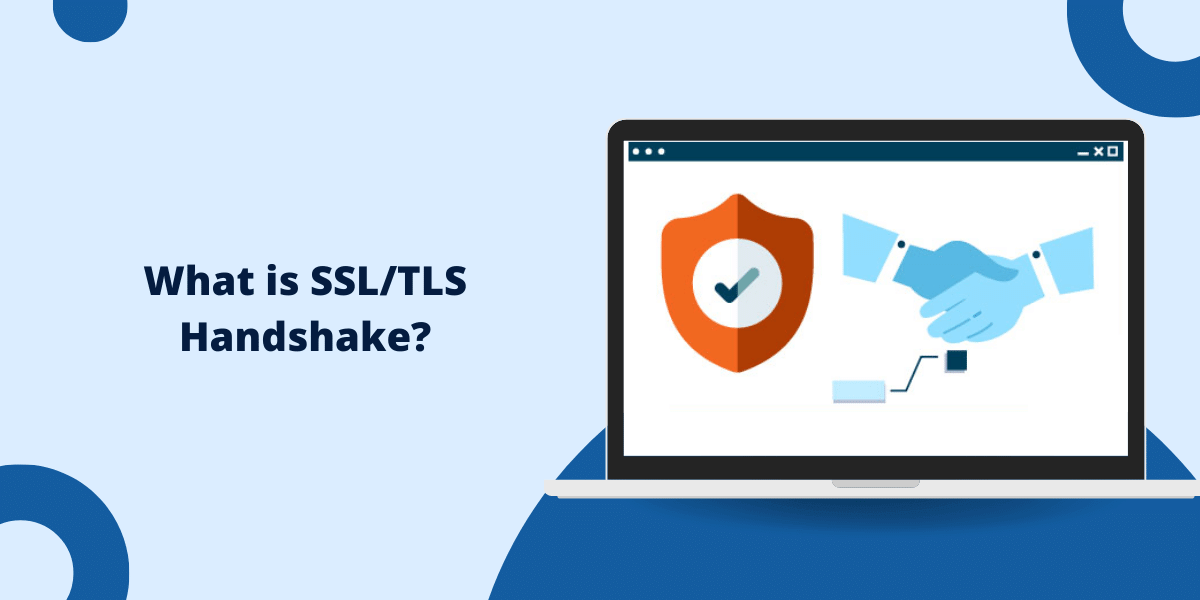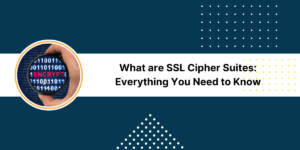Organizations cannot afford to neglect their software security needs. Businesses that implement advanced tech stacks simultaneously increase their exposure to multiple software security threats, which endanger their data and operational stability while damaging their reputation. The IBM Cost of a Data Breach Report reveals data breaches now cost organizations an average of $4.45 million each year, and this expense continues to increase annually.
The security standard TLS represents the updated version of Secure Sockets Layer (SSL), which defends against many standard software threats. The article analyzes critical software integration vulnerabilities together with SSL protection strategies.
Common Security Risks in Software Integration
- Man-in-the-Middle (MITM) Attacks
- Insecure APIs
- Lack of Authentication and Authorization
- Data Exposure During Integration
- Poorly Configured SSL/TLS Implementations
1. Man-in-the-Middle (MITM) Attacks
The absence of proper encryption during software system internet communication creates an opportunity for hackers to easily steal data as it travels through the network. Hackers use MITM attacks to intercept system communications between two endpoints, which allows them to steal or modify information. The risk level becomes very high when financial applications like payment processors or online banking software experience such vulnerabilities.
Capital One became a victim of a 2019 data breach that exposed more than 100 million customer records. The communication encryption weaknesses played a role in the breach but they did not act as the sole reason for it.
2. Insecure APIs
The current software integration process depends entirely on APIs. Security weaknesses in APIs let attackers achieve unauthorized access to systems together with sensitive data exposure.
API security incidents affect 94% of organizations, according to a Salt Security report.
3. Lack of Authentication and Authorization
System impersonation becomes easier when organizations fail to implement strong authentication controls. System users and unauthorized actors gain inappropriate data access and perform unauthorized actions through insufficient authorization controls.
X (former Twitter) experienced a massive breach in 2020 because attackers used social engineering tactics to circumvent internal authentication protocols, thus gaining access to user accounts belonging to Elon Musk and Barack Obama.
4. Data Exposure During Integration
Sensitive information, including personal identifiers and payment data, becomes vulnerable to interception during software component data transmissions when proper encryption is absent.
The risk level increases when organizations integrate with outdated legacy systems or vendors who fail to meet current software security requirements.
5. Poorly Configured SSL/TLS Implementations
The security benefits of SSL/TLS data transmission become ineffective because systems remain vulnerable to attacks through SSL stripping and downgrade attacks when users implement improper encryption algorithms or mismanage certificates.
SSL/TLS Resolves Security Vulnerabilities
SSL and TLS represent cryptographic protocols which protect data communication networks, especially the internet, through network protection. The protocols maintain crucial functions to protect client-server data transmissions by ensuring privacy and integrity alongside authentication verification. The software security of cloud services, together with API integrations and web-based systems, depends heavily on SSL/TLS because it solves various essential software vulnerabilities.
1. Data Encryption
SSL/TLS delivers encryption as its core function to protect data transmission between networked systems. Network surveillance methods that include packet sniffing or other data capture methods will not reveal the intercepted data to hackers because they cannot interpret it. Encryption algorithms convert data into ciphertext so unauthorized parties cannot access its contents. The decryption key possessed by the intended recipient enables him to transform the protected information into functional data. The encryption method effectively protects against both Man-in-the-Middle (MITM) attacks and passive data leaks that represent major threats to unencrypted communication systems.
2. Authentication and Trust
SSL/TLS provides security beyond encryption through authentication methods that verify correct communication entities. SSL certificates that come from trusted Certificate Authorities (CAs) serve to verify both servers and specific cases of client identities. During the initial connection attempt between a client and server, the browser performs a certificate verification check to verify server legitimacy and prevent attacks from impostor or malicious servers. Users can avoid spoofing attacks by validating server identity through SSL certificates that establish trust through secure authentication processes conducted by recognized authorities.
3. Data Integrity
The security assurance of SSL/TLS includes protecting data from modifications during transmission. The combination of Message Authentication Codes (MACs) and cryptographic hashing enables data integrity assurance through this method. The technologies create data fingerprints during transmission which are subsequently checked upon arrival. The communication system will reject data when fingerprints do not match, which indicates potential tampering. Active attacks that involve message modifications during transit become ineffective because SSL/TLS ensures data exchange reliability and accuracy through this protection mechanism.
4. Protection of API Traffic
Web-based API data exchanges require essential protection because software applications now interact with each other through APIs (Application Programming Interfaces). API endpoints experience regular security threats because attackers perform eavesdropping operations while attempting injection attacks and replay attacks. API traffic encryption through SSL/TLS protects both data content and prevents unauthorized access and alteration during its transport to the destination. Any business utilizing web services needs this protection because APIs transmit essential commands together with tokens and credentials.
Best Practices for Using SSL in Software Integration
SSL/TLS provides strong security, but its success depends on proper implementation practices. Organizations must follow best practices to establish robust security protection throughout their systems and services.
1. Use Strong Certificates
All SSL certificates must implement contemporary encryption protocols which provide maximum security. Organizations must update their SSL certificates to use SHA-256 hashing or newer standards because SHA-1 certificates along with previous standards are no longer secure. Forward secrecy must be activated since it protects past communication sessions from being compromised even when encryption keys become vulnerable. Organizations must disable all outdated SSL versions 2.0 and 3.0 together with insecure cipher suites including RC4. Modern TLS versions such as TLS 1.2 and TLS 1.3 provide current and resilient encryption standards against known exploits.
2. Implement Certificate Pinning
The client component of mobile apps and browser extensions utilizes certificate pinning as an implementation which accepts only particular SSL certificates and public keys through fixed configuration. Through this approach, attackers cannot use fake certificates from rogue or compromised certificate authorities. The pinned client will block connections from fake certificates that attackers manage to get CA to issue because of this implementation, which provides additional security protection against the certificate trust model risks.
3. Automate Certificate Renewal
SSL certificates have expiration dates, usually ranging from 90 days to a year. The non-renewal of certificates before their expiration date results in service interruptions and increases system exposure to potential threats. Businesses need to move away from manual renewal processes because they contain errors, which automated certificate management tools like Let’s Encrypt and enterprise-grade solutions can prevent. Tools which handle complete certificate lifecycle processes generate and install certificates and perform renewals and revocations and thus minimize risks and system downtime.
4. Monitor for Misconfigurations
The validity of an SSL/TLS certificate does not protect systems from security vulnerabilities when its configurations are not properly set. SSL implementation testing should be performed by organizations through the help of Qualys SSL Labs and other tools which provide grading systems and detailed reporting. Through regular monitoring, organizations can validate their SSL configurations against industry standards to detect improper protocol setups and weak cipher usage and broken chain configurations.
5. Secure Endpoints Beyond SSL
SSL encrypts data while it moves between systems, yet it fails to protect endpoint weaknesses. Firewalls along with anti-malware software and intrusion detection systems and authentication controls with MFA should be implemented on all devices and servers and client applications for complete protection. The security of endpoint systems prevents attackers from intercepting or accessing encrypted data after it has been transmitted or before transmission completes.
The Role of SSL in Compliance and Trust
Compliance
The current data protection regulations and industry-specific standards require encryption for all sensitive information transferred between systems. SSL/TLS functions as an established method to implement this requirement. The General Data Protection Regulation (GDPR) of Europe and the Health Insurance Portability and Accountability Act (HIPAA) of the U.S. and the Payment Card Industry Data Security Standard (PCI-DSS) contain rules that demand or suggest encrypted communication to protect user information. SSL implementation helps organizations fulfill their legal requirements and provides breach protection under the law.
User Trust
The growing worries about data privacy alongside identity theft make users depend on security indicators to trust a platform. A website displays “HTTPS” in the URL and shows a padlock icon to the browser when SSL is used. These visual indicators provide users with assurance about the secure handling of their information. Research demonstrates HTTPS websites receive higher user trust levels and transaction completion rates than non-encrypted websites.
When SSL Isn’t Enough: Layered Security
The SSL/TLS protocol offers strong security for data transmissions, yet it stands as a solitary security measure. A total cybersecurity plan implements several defensive layers to protect organizations from advancing security threats.
Endpoint Security
System and server protection requires implementation of antivirus software combined with intrusion prevention systems and enforced access control measures. The encryption process does not protect against data exposure from compromised devices that operate as entry points to the network before data reaches it.
Code-Level Protections
Secure development practices are critical. Secure coding tools such as Snyk and Veracode and Checkmarx enable developers to detect known vulnerabilities in their source code and dependencies through automated scanning. The tools can locate problematic libraries and injection vulnerabilities and out-of-date packages that would enable attackers to bypass SSL encryption completely.
Real-Time Monitoring
Threat detection systems functioning in real time enable organizations to detect abnormal behavior which allows them to initiate immediate responses. Organizations utilize IDS along with log analyzers and SIEM platforms to detect and prevent attacks before they become more serious.
Zero Trust Architecture
The traditional security models base their trust on everything found inside the network. The Zero Trust model requires authentication for all devices and users before granting access for each request from any network location. Zero Trust models operate under the assumption that breaches will occur, so they establish access limitations accordingly. Zero Trust implementation with SSL provides advanced security controls that reduce attack points in the system.
Final Thoughts
The expanding nature of digital ecosystems generates increasingly complex security risks. The implementation of software integration solutions delivers operational advantages yet creates additional entry points for software security vulnerabilities. The correct implementation of SSL/TLS stands as a leading defensive measure against many security threats.
SSL functions as an essential security measure, but organizations need to use it within a complete security system. Businesses need to handle software security through complete approaches that include secure development practices along with regular audits and active monitoring.
Organizations that focus on encryption and validation, together with active monitoring, will defend themselves against cyber threats while preserving user trust because software threats have become inevitable in today’s digital environment.

Priya Mervana
 Verified Web Security Experts
Verified Web Security Experts
Priya Mervana is working at SSLInsights.com as a web security expert with over 10 years of experience writing about encryption, SSL certificates, and online privacy. She aims to make complex security topics easily understandable for everyday internet users.



